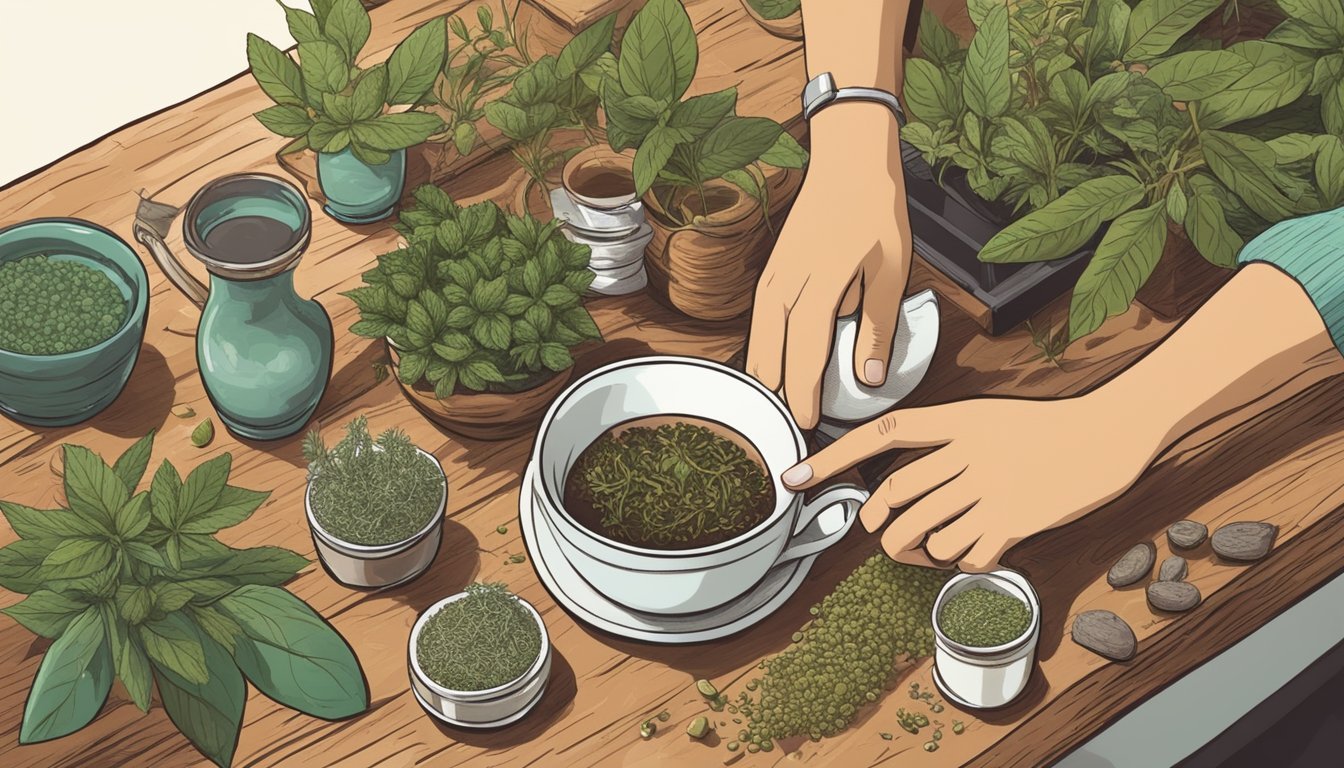Yerba Buena Substitutes
Top Alternatives for Flavor and Medicinal Use
When you find yourself lacking yerba buena for your next kitchen creation, knowing the suitable substitutes can save your dish. Yerba buena, often known as Mentha arvensis or Clinopodium douglasii, is a versatile herb commonly used in teas, culinary dishes, and even gardening landscapes. Its distinct minty flavor elevates various recipes, but finding the right replacement can keep you on track when supplies are short.
For those drawn to the kitchen’s allure, spearmint, also known as Mentha spicata, stands as an excellent substitute for yerba buena. This herb, widely available and similarly aromatic, can seamlessly take yerba buena's place in cooking and tea recipes.
Gardeners and home chefs alike should consider another viable option: Satureja douglasii, also known as yerba buena in some regions. This plant adds a comparable aromatic touch to dishes and tea preparations, ensuring your culinary efforts remain uncompromised.
Understanding Yerba Buena
Yerba Buena, known for its aromatic mint-like fragrance and medicinal properties, is a versatile herb with deep historical roots. Key aspects include its botanical characteristics, historical applications, and health benefits.
Botanical Profile
Yerba Buena, scientifically recognized as Satureja douglasii or Clinopodium douglasii, is an aromatic herb native to the western and northwestern regions of North America, extending from Alaska to California. Characterized by its sprawling, mat-forming perennial growth, this plant thrives particularly along coastal areas. It displays small white flowers and has mint-like leaves that emit a pleasant fragrance when crushed. Known as "good herb" in Spanish, Yerba Buena remains popular among native plants due to its beneficial properties and ease of identification.
Historical Uses
Yerba Buena has been utilized by various cultures for centuries. Indigenous Native American tribes first used this herb for its therapeutic effects and as a vital component of traditional remedies. In Mexican cuisine, Yerba Buena brings a refreshing minty flavor to a wide array of dishes and beverages, including salsas and the traditional "agua fresca." The plant also holds cultural significance in the Philippines where it is incorporated into both cooking and traditional medicine. These historical uses highlight the herb's versatility and long-lasting value across different societies.
Medicinal Benefits
The medicinal benefits of Yerba Buena are extensive, stemming from its various properties such as anti-inflammatory, antibacterial, and carminative effects. Tea made from Yerba Buena leaves is commonly used to alleviate digestive issues, cramps, and colics. Its anti-inflammatory and anti-spasmodic properties make it a popular remedy for reducing muscle pain and inflammation. The calming effects of the herb also help in relaxing both the body and mind, making it an effective natural remedy for stress and anxiety. These benefits underscore the herb's persistent relevance in contemporary herbal medicine.
Cultivation and Care
Yerba Buena requires proper planting techniques, well-drained soil, adequate sunlight, and minimal maintenance to thrive and provide its aromatic and medicinal benefits.
Planting Guidelines
Plant Yerba Buena in an area with full to partial shade. Ensure proper spacing to avoid overcrowding, usually about 12 to 18 inches apart. When planting, dig a hole large enough to accommodate the root ball. Make sure the soil is loose and well-aerated to promote root growth. For container planting, choose wide, shallow pots to allow the plant to spread.
Soil and Water Needs
Yerba Buena prefers loamy, well-drained soil enriched with organic matter. Adding peat moss can improve soil texture and moisture retention. Regular watering is essential, but avoid waterlogging. Maintain soil moisture using mulch, which helps keep the roots cool and retains soil water. It's important to avoid over-fertilizing; a light application of balanced fertilizer once a year is sufficient.
Light and Temperature Requirements
Position Yerba Buena where it receives full to partial shade. It thrives in moderate climates but can tolerate some heat. Ideally, the temperature should be between 60°F to 80°F. Extreme cold or frost can damage the plant, so protection or indoor relocation during harsh winters is recommended. Ensure the plant gets at least 4-6 hours of indirect sunlight daily to maintain healthy growth.
Pruning and Maintenance
Regular pruning helps maintain the plant's shape and encourages denser growth. Trim the tips regularly to prevent legginess and to promote a bushier appearance. Removing dead or damaged leaves improves overall plant health. Keep an eye on pests and diseases, though Yerba Buena is generally resilient. Minimal maintenance is required, making it an easy herb to cultivate for both novice and experienced gardeners.
Yerba Buena in the Garden
Yerba Buena is an aromatic plant that brings multiple benefits to a garden. Its fragrant leaves and low-growing habits make it ideal for various garden applications, from ground cover to enhancing biodiversity.
Landscape Design
Yerba Buena is an attractive choice for landscape design due to its ability to spread quickly and create a lush, green cover. This ground cover is particularly useful in rock gardens and lawns, where its low-growing nature prevents soil erosion and suppresses weed growth.
In addition to its foliage, Yerba Buena produces white flowers that offer a subtle yet appealing aesthetic. These flowers can accentuate more colorful plants and enhance the overall visual appeal of a meadow or garden.
Wildlife Attraction
The inclusion of Yerba Buena in a garden can significantly benefit wildlife. Its aromatic leaves attract various pollinators, such as bees and butterflies, contributing to the garden's ecological health. This makes it an excellent native plant for gardeners looking to support local wildlife.
Moreover, Yerba Buena can serve as a natural habitat for beneficial insects and small animals. The plant's dense growth provides shelter and food, promoting biodiversity. Its presence can reduce the need for chemical pest control by maintaining a balanced ecosystem.
Companion Planting
Yerba Buena excels in companion planting, offering advantages for neighboring plants. It acts as a natural pest repellent, deterring insects without the use of harmful chemicals. This is particularly beneficial for flowers and edible plants, ensuring a healthier, more productive garden.
Additionally, Yerba Buena can improve soil health with its extensive root system, which helps maintain soil structure and moisture levels. When planted alongside other herbs and vegetables, Yerba Buena enhances growth and provides a mutually beneficial environment for all companion plants involved.
Propagation Techniques
To propagate Yerba Buena effectively, it is essential to understand the two primary methods: growing from seeds and using cuttings. Each technique requires specific steps, tools, and conditions for optimal growth.
Growing from Seeds
Growing Yerba Buena from seeds can be a bit challenging but rewarding. Seeds should be sown in the spring, as this period provides the ideal conditions for germination.
Preparation: Use seed trays or small pots filled with high-quality soil mix that drains well.
Sowing: Surface sow the seeds, pressing them lightly into the soil without covering them too deeply.
Watering: Mist the soil surface gently and maintain consistent moisture using an automatic misting system if available.
Environment: Seeds require bright, indirect sunlight and temperatures between 15 to 30 °C.
Growth Period: Germination typically takes a few weeks. Transplant seedlings once they are strong enough to handle.
Cuttings and Division
Propagation from cuttings is more reliable for Yerba Buena and often results in faster growth compared to seeds.
Selecting Cuttings: Choose healthy, vibrant, and pest-free stems. Each cutting should have at least four leaves.
Preparing Cuttings: Use a sharp pruner to cut a 4-6 inch section of healthy stem. Remove the lower leaves to expose the nodes.
Rooting Hormone: Applying a rooting hormone to the cut end can enhance root development.
Planting: Insert the cutting into moist, well-draining soil in a pot or container.
Watering: Keep the soil consistently moist but not waterlogged. Use chamomile tea as a fungicide to prevent damping off.
Root Development: New roots typically form within 2 to 4 weeks. Once established, transplant cuttings to their final location.
Both methods provide viable options for propagating Yerba Buena, with cuttings being the more straightforward approach for most gardeners. By following these detailed steps, enthusiasts can ensure successful growth and a lush, aromatic plant collection.
Harvesting and Preservation
Properly harvesting and preserving Yerba Buena ensures its optimal flavor and efficacy. The morning is ideal for harvesting as the leaves are most vibrant, and drying techniques are essential for long-term storage.
Optimal Harvesting Time
The best time to harvest Yerba Buena is in the morning. During this period, the plant’s essential oils and flavors are at their peak. Farmers and gardeners should look for vibrant, green leaves and avoid those that appear wilted or diseased.
To protect the plant and encourage regrowth, shears should be used to make clean cuts right above a leaf node. Regular harvesting can also promote a fuller, bushier growth. Avoid harvesting in the winter as the plant's growth rate slows, potentially harming its vitality.
Drying and Storing
Once harvested, Yerba Buena leaves should be dried promptly to preserve their properties. Spread the leaves in a single layer on a clean, dry cloth or screen in a well-ventilated area away from direct sunlight. This process can take several days, depending on humidity and temperature.
After drying, leaves should be stored in an airtight container in a cool, dark place to maintain their potency. Labeling the container with the harvest date can help track freshness. Properly dried and stored Yerba Buena can last for several months, providing a year-round supply for culinary and medicinal uses.
Culinary Applications
Yerba Buena is a versatile herb used in both sweet and savory dishes to enhance flavor. In cooking, it is frequently substituted with spearmint due to their similar profiles.
Yerba Buena in Recipes
Yerba Buena is often used fresh or dried. Fresh leaves are particularly effective in adding a minty flavor to dishes such as salads, marinades, and garnishes. When substituting for dried herbs, use twice as much fresh Yerba Buena. Dried Yerba Buena, on the other hand, is ground and used in seasoning mixes for meats and stews. This application brings a depth of flavor that complements hearty ingredients.
Sweet and Savory Dishes
In savory dishes, Yerba Buena pairs well with meats and stews. It imparts a refreshing minty taste that enhances the overall flavor. For instance, rubbing dried Yerba Buena on meats before roasting provides a unique taste experience. It also blends well in dishes that include sweet potatoes, such as in Cuban cuisine, where it complements the natural sweetness of the vegetable.
In sweet dishes, Yerba Buena can be used to add an unexpected twist. Desserts like mint-infused ice creams or mojitos benefit from its fresh leaves for a burst of flavor. When more robust, fresh Yerba Buena shines in recipes that call for a minty essence, similar to spearmint.
Alternative Herbs and Substitutes
Yerba buena, also known as hierba buena, can be substituted with several herbs. Each substitute offers unique characteristics that can enhance various dishes. This section explores equivalent flavors and practical substitutes for cooking.
Equivalent Flavors
Mint varieties can serve as excellent replacements. Spearmint (Mentha spicata), with its mild and sweet flavor, closely mirrors yerba buena.
Peppermint offers a stronger, more intense flavor, ideal for recipes that require a robust mint presence. Satureja douglasii and Satureja chamissonis are also mint substitutes, providing similar aromatic properties.
Basil and oregano can sometimes be used for their aromatic qualities in dishes where a hint of earthiness is appreciated.
Substitute Similarity to Yerba Buena Spearmint Mild, sweet, similar profile Peppermint Intense, robust flavor Satureja douglasii Aromatic, minty
Substitutes in Cooking
When cooking, it's essential to consider the herb's flavor profile and intensity. For example, spearmint can be used in equal amounts to yerba buena. Its mildness makes it versatile for salads, dressings, and mojitos.
Peppermint should be used more sparingly due to its potent flavor. It works well in desserts and teas.
For a hint of mint without overpowering other ingredients, Satureja douglasii or Satureja chamissonis can be used in stews and soups.
When using oregano or basil as a substitute, it's best for dishes where a subtle mint backdrop suffices. They add complexity without dominating the dish's flavors.
Health and Wellness Uses
Yerba buena, known for its medicinal properties, has been traditionally used to treat various health ailments. Notably, it benefits both physical conditions and mental wellness.
Traditional Remedies
Yerba buena has long been utilized in folk medicine due to its potent medicinal properties. It is widely known for its anti-inflammatory effects, which are instrumental in alleviating headaches, cramps, and muscle pains. When applied topically, it helps heal wounds and can reduce inflammation in the affected area.
It is also effective in treating colds and soothing digestive issues, such as indigestion and bloating. Consuming yerba buena tea can help clear respiratory passages and ease symptoms associated with respiratory infections. This herb is often used to relieve stomach cramps, thanks to its carminative properties.
Aromatherapy and Relaxation
In addition to its medicinal uses, yerba buena is beneficial in aromatherapy for stress relief and anxiety management. The scent of yerba buena can be calming and is frequently used in essential oils and diffusers to promote relaxation.
Burning yerba buena or inhaling its essential oil can help reduce mental fatigue and tension. Its soothing aroma can improve mood and create a tranquil environment. For those dealing with chronic stress or anxiety, yerba buena's calming effects can provide significant relief, making it a valuable natural remedy for mental well-being.
Environmental Impact and Sustainability
Yerba Buena substitutes can influence ecological balance and gardening practices. Native plants and careful management are crucial for positive environmental effects.
Biodiversity and Habitat
Using Yerba Buena substitutes like native plants supports biodiversity. Native species attract local butterflies, bees, and other wildlife, promoting a healthy ecosystem. These plants are adapted to the local environment, requiring less water and fewer inputs, which reduces disruptions to natural habitats.
Reintroducing native plants can help restore degraded areas, providing shelter and food sources for wildlife. This approach maintains habitat integrity, supporting a wide range of species and contributing to overall ecosystem resilience.
Sustainable Gardening Practices
Sustainable gardening practices with Yerba Buena substitutes emphasize the use of organic matter. Compost and natural mulches improve soil health, boost water retention, and provide nutrients. Such practices minimize the need for chemical fertilizers and pesticides, reducing environmental contamination.
Additionally, practices like mulching and companion planting enhance soil cover and biodiversity, creating a more balanced and resilient garden. This not only fosters a healthy growing environment but also conserves resources and supports ecological stability.











